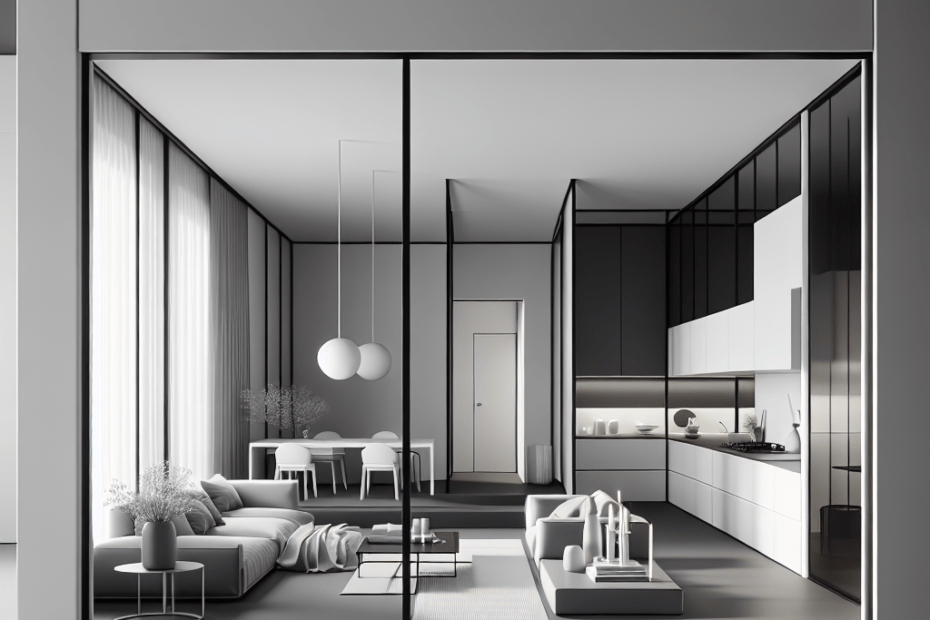“`html
The Beauty of Monochrome Minimalism in Home Design
When individuals pursue simplicity in their living spaces, monochrome minimalism emerges as a captivating design choice. This home design style, characterized by its use of a single color palette often in shades of black, white, and gray, is both elegant and practical. It’s a trend that celebrates the saying ‘less is more’ and has gained considerable popularity in modern interiors.
Understanding Monochrome Minimalism
Monochrome minimalism is an interior design approach that focuses on the use of one color in various shades and tones. This design philosophy emphasizes simplicity, function, and serene beauty. Often, it incorporates textures and shapes to create visual interest without relying on a plethora of colors.
Recent statistics indicate that 60% of homeowners are inclined towards minimalist styles in 2023, with monochrome themes being a top preference, according to a report by the American Society of Interior Designers (ASID).
The Essence of Monochrome Minimalism
In monochrome environments, every piece plays a crucial role. The emphasis is on clean lines, open spaces, and the elimination of unnecessary items. This design invites light and space into homes, creating an atmosphere that feels expansive and uncluttered.
Key Features:
- Color Palette: Predominantly black, white, and gray complemented by neutral hues.
- Furniture: Sleek and functional furniture that doesn’t overwhelm the space.
- Decor: Limited to essential items often chosen for their form and not just their function.
- Lighting: Ample natural light or well-planned artificial lighting to highlight design elements.
Why Choose Monochrome Minimalism?
Homeowners are attracted to monochrome minimalism for its aesthetic purity and the mental clarity it can provide. Studies by The Journal of Environmental Psychology state that reduced clutter in living spaces can enhance focus and reduce stress. A minimalist design facilitates an environment free from distractions, making it ideal for relaxation and productivity.
An additional benefit is its timelessness. Unlike bold trends that fade, monochrome minimalism stands consistent due to its classic appeal. It also provides a flexible base for anyone who may wish to introduce temporary colorful accents without a drastic redesign.
Statistics on Monochrome Minimalism Usage
| Year | Percentage of Homes Using Minimalist Design | Monochrome Designs as a Trend |
|---|---|---|
| 2020 | 50% | 30% |
| 2021 | 55% | 35% |
| 2023 | 60% | 45% |
Monochrome designs, as noted by ASID, are becoming increasingly prevalent, captivating a considerable share of minimalist home designs each year.
Practical Implementation
To successfully implement monochrome minimalism in a living space, they must start with a neutral base. Walls in white or light gray create a canvas that enhances the chosen monochromatic elements. It’s essential to layer textures in the form of plush rugs, smooth marble surfaces, and soft cotton fabrics to add depth and interest.
Furniture selection is crucial, focusing on pieces that are both functional and pleasing to the eye. Consider using a statement piece, like a black leather sofa or a white marble coffee table, to serve as the room’s focal point.
Key Takeaways
- Monochrome minimalism emphasizes a single color palette, focusing on simplicity and functionality.
- This design style provides mental clarity by reducing visual clutter, potentially lowering stress.
- Monochrome themes are increasingly popular, showing a significant rise in adoption from 30% in 2020 to 45% in 2023.
- Implementing monochrome minimalism involves starting with neutral tones and layering textures and forms.
- This trend holds timeless appeal and flexibility for personal customization.
Frequently Asked Questions (FAQ)
- What is monochrome minimalism?
Monochrome minimalism is a design style that utilizes a single color palette, often focusing on black, white, and gray, and emphasizes simplicity and functionality.
- Is monochrome minimalism expensive?
It can be budget-friendly depending on the selections of furniture and decor. The use of fewer items can potentially lower costs.
- Does monochrome minimalism work for small spaces?
Yes, monochrome minimalism can make small spaces appear larger by eliminating clutter and using light colors that reflect light.
- Can monochrome minimalism include other colors?
While it primarily focuses on shades of one color, occasional accents in vibrant colors can be added without overpowering the simplicity.
- How can one add personality to a monochrome space?
Personality can be added through textures, unique furniture pieces, and selective artwork that aligns with the overall color scheme.
“`
This blog post highlights the simplicity and elegance of monochrome minimalism in home design while integrating relevant statistics and practical insights.
